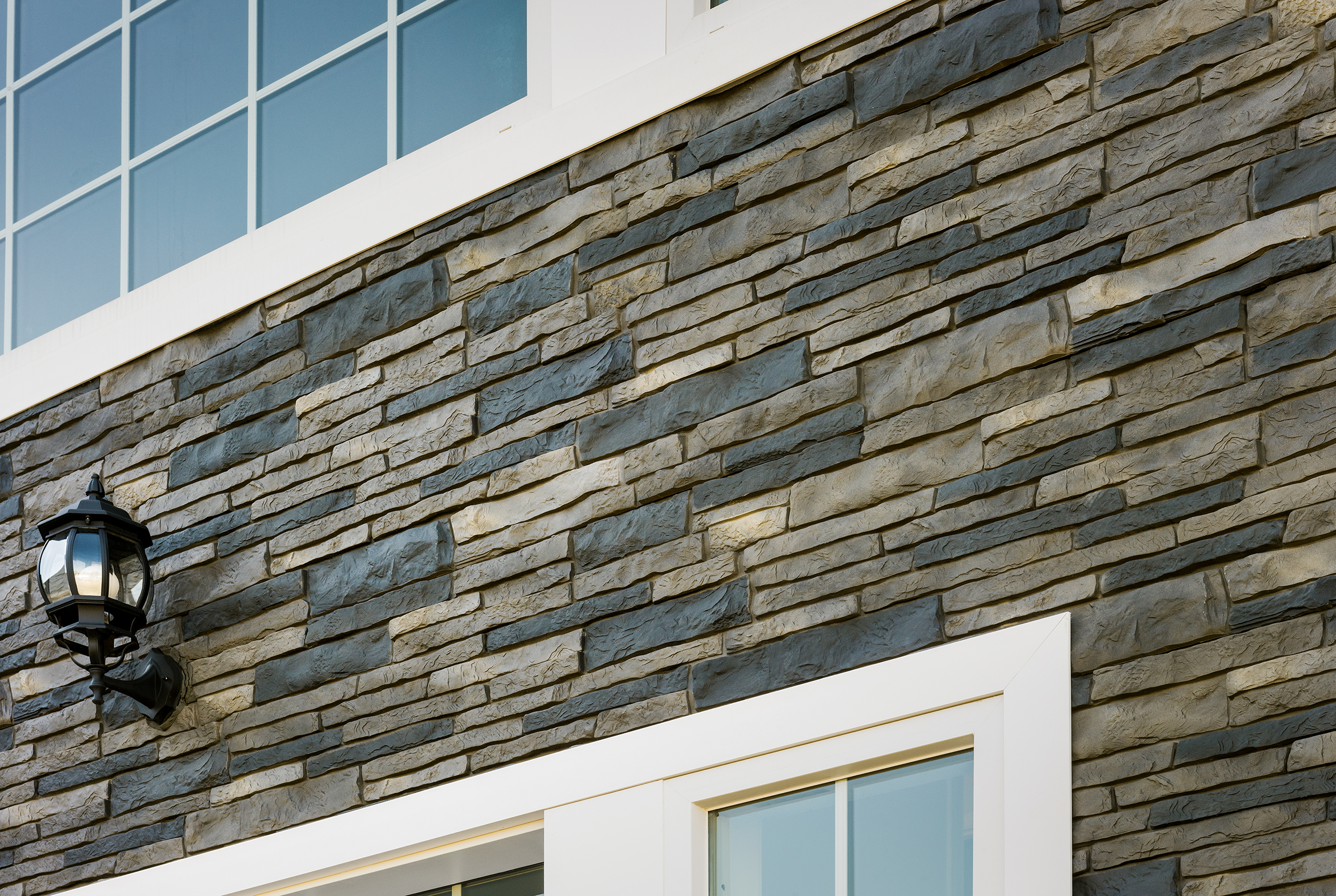Stone veneer has changed modern home design by offering the classic look of natural stone in more practical formats, but different stone veneer products perform very differently over time. How long your stone veneer lasts depends on the type of material you choose, how well it is installed, your local weather conditions, and how you maintain it.
Average Lifespan of Stone Veneer
It largely depends on which type of stone veneer you choose, the quality of installation, and maintenance.
The Three Types of Stone Veneer Siding That Are Common on Residential Homes
Stone veneer falls into three main categories, each with dramatically different lifespans. Natural stone veneer sits at the top of the durability pyramid, often lasting well over a century with basic maintenance. Think about it – this material has already survived thousands of years underground, so a few decades on your home’s exterior is nothing by comparison.
Composite stone veneer has emerged as the smart compromise option. These engineered products typically deliver 30 to 75 years of reliable performance by combining crushed natural stone with advanced binding technologies. You get much of natural stone’s durability without the premium price tag.
Manufactured stone veneer, while the most budget-friendly option, provides 20 to 50 years of service life. Recent improvements in manufacturing have pushed some premium manufactured products toward the higher end of this range, with several companies now backing their products with 50-year warranties.
Key Factors Affecting Longevity
Here is what most homeowners do not realize: the quality of installation often matters more than the material itself. Poor installation can cut your stone veneer’s lifespan in half, regardless of which type you choose. Proper water management, adequate substrate preparation, and attention to expansion joints make the difference between a decades-long investment and an expensive mistake.
Your local climate plays a huge role too. Homes in harsh freeze-thaw environments or areas with intense UV exposure will see different performance from the same materials compared to more moderate climates.
The bottom line? While natural stone veneer costs more upfront, its superior longevity often makes it the most economical choice when you calculate costs over 30-plus years. But if budget constraints are tight, today’s composite options offer a compelling middle ground that was not available to homeowners just a decade ago.
Maintaining Your Stone Veneer
Protecting your stone veneer does not require extensive expertise or specialized equipment – just consistent attention and the right approach. Think of maintenance as an insurance policy that keeps your exterior looking great while preventing costly repairs down the road.
Start with the basics: a gentle sweep using a soft-bristled brush removes surface debris before it has a chance to stain or accumulate. This simple step prevents organic matter from breaking down against your veneer and creating discoloration.
When deeper cleaning becomes necessary, stick to the gentle approach. Mix a small amount of mild dish soap with water – the same solution you would use for washing your car works perfectly. Use a soft cloth or sponge to work the solution across the surface, then rinse thoroughly with clean water. The key is removing all soap residue, which can attract dirt if left behind.
What Never to Use
Resist the temptation to break out power tools or harsh cleaners. Pressure washers, wire brushes, and acidic cleaners might seem like time-savers, but they can permanently damage your veneer’s surface texture and protective qualities. Even household items like vinegar or bleach are too aggressive for stone surfaces.
Your Seasonal Inspection Checklist
Twice-yearly walkarounds – ideally in spring and fall – help you catch small issues before they become expensive problems. Look for hairline cracks in individual stones, gaps in mortar joints, or areas where caulking around windows and trim has pulled away. Pay special attention to areas that receive heavy weather exposure.
During fall inspections, clear away any accumulated leaves or organic debris. These materials retain moisture and can cause staining or even promote biological growth if left in place over winter months.
When to Take Action & Seek Professional Maintenance
Address white, chalky deposits (efflorescence) quickly by gently brushing them away when dry. If staining occurs, tackle it promptly with your mild soap solution before it has time to set permanently into the stone’s surface.
Most importantly, ensure water flows away from your foundation and does not pool against the veneer. Proper drainage prevents the moisture issues that cause most long-term veneer problems.
FAQs: Stone Veneer Lifespan
Our most frequently asked questions regarding the lifespan of stone veneer:
Why does my stone veneer keep falling off?
Stone veneer falls off when water gets behind it and then freezes, which creates enough pressure to break the bond holding it to the wall. Most problems stem from sloppy installation work – contractors who skip proper surface prep, do not install moisture barriers, or spread adhesive too thin. If you install stone when it is too cold outside, the adhesive will not cure properly and creates a weak bond from day one. Over time, these issues snowball as more water finds its way behind loose stones, eventually causing whole sections to pop off and hit the ground.
How much does it cost to replace stone veneer?
Stone veneer replacement costs vary significantly depending on the type of material you choose and the size of your project. Natural stone veneer typically runs much higher than manufactured alternatives, while labor costs fluctuate based on your location and the complexity of the installation. Small repair jobs might be relatively affordable, but replacing large sections or entire walls can become quite expensive. Getting multiple quotes from local contractors is essential since pricing can differ dramatically between different suppliers and installation crews.
Should I seal my stone veneer?
Sealing stone veneer depends on the type of stone and your local climate conditions. Natural stones like limestone and sandstone typically benefit from sealing to prevent water absorption and staining, while denser materials like granite may not require it. Manufactured stone veneer usually comes pre-sealed from the factory, though reapplication every few years can extend its lifespan.
What are the disadvantages of natural stone veneer?
Natural stone veneer comes with several notable drawbacks, starting with its significantly higher cost compared to manufactured alternatives. The material is much heavier than cultured stone, requiring additional structural support and making installation more complex and labor-intensive. Natural stone is also more porous and prone to staining, weathering, and color variation over time, especially with softer stones like limestone and sandstone. Additionally, repairs can be challenging since matching the exact color and texture of the original stone is often difficult or impossible.
Contact Us for Your Siding Replacement Project
Your home deserves materials that deliver lasting performance and curb appeal that will not fade or deteriorate over time. When you are considering a siding replacement project, the choices you make today will impact your home’s appearance and maintenance requirements for decades to come. Modern composite stone options like TandoStone composite stone veneer offer the beauty of natural stone without the weight concerns or maintenance challenges, resisting common problems like fading, cracking, and moisture damage. These engineered solutions work seamlessly with fiber cement and vinyl siding options to create a cohesive exterior design that enhances your home’s architectural character while minimizing ongoing upkeep.
Choosing quality materials is only half the equation – proper installation determines whether your investment delivers its promised performance. Working with certified contractors like DaBella, a James Hardie Elite Preferred contractor, ensures your project meets manufacturer specifications and warranty requirements from day one. Our expert team guides you through material selection and handles every aspect of installation with the precision that premium materials deserve.
Do not let another season pass with exterior materials that are not performing at their best. Contact DaBella today at 844-DaBella to schedule your complimentary consultation and discover how the right combination of materials and professional installation can transform your home’s exterior. Get your free quote and take the first step toward lasting durability, enhanced curb appeal, and the peace of mind that comes with a properly executed siding replacement project.

